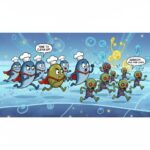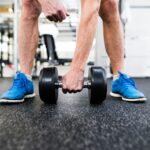Muscle pulls happen to everyone. It’s part of life. They happen to “Johnny Six Pack” who sits on the couch all day drinking beer, as well as exercise fanatics and health nuts like me (PJ).
Different people handle them differently, though. When Johnny Six Pack gets injured, he babies it, limps around, and complains about it until it eventually goes away (if it ever does). This will usually take a long time because of his attitude and his horrible health.
The exercise fanatic and health nut (me), on the other hand, knows just what to do and basically ignores it, not even telling anyone in some cases, because there are mental and emotional components to this as well. This post will discuss what I do when I have a muscle pull. This might not be right for you, though, so be sure to run it by a qualified medical professional before implementing any advice from anyone, including me.
Yes, it’s true. I occasionally experience muscle pulls. I personally test all exercises, equipment, techniques, and methods we do at X Gym before releasing them to the members. If I do get a pull or tweak, it disqualifies that thing from being at X Gym.
The reason pulls and tweaks are so rare at X Gym compared to all the other gyms is because of my testing and commitment to safety, but also due to the built-in safety features of our methodology and principles of TUT and CMF, which all necessitate light weights and controlled motions. When X Gym members get a pull or tweak, it’s usually while doing something outside of X Gym. But even then, it’s rarer than other people because X Gym style also makes people more resistant to injuries in general because of its functional fitness emphasis.
I mention pulls and tweaks in this post because they are different. A muscle pull is sudden and sometimes accompanied by a “pop” sound or sensation. It is constantly painful, even at rest, and sometimes involves visible symptoms like swelling or a bruise. Movement is restricted and rest of that muscle is often wise, but other movements and exercises are helpful because of increased circulation, which is good for the healing process. A pull can last 2-6 weeks. This is very rare for me, as I am only testing new things in a very safe way, and never with heavy weights or ballistic motions like you would see at a CrossFit, for instance, but they still happen from time to time.
A tweak is a slight pull, but without a “pop” or visible symptoms. It’s usually noticeable when it happens, but sometimes later, within an hour after it happens. It is (slightly) painful with movement, but usually not at rest. This can take 1-2 weeks to heal, but movement isn’t restricted and exercise is still fine – even encouraged – because of the increased blood flow advantage. This is also rare for me, and when it happens, I ignore it so I can stay active and heal it faster.
With pulls and tweaks, there is a physical component to the pain, but there are also mental and emotional components. If you are like me, and most other people, paying attention to pain makes it worse. The best example of this is my two-year-old grandson. When he falls on his face, it hurts. Sometimes even with a visible mark. However, he has convinced himself (like many toddlers) that if an adult kisses the point of pain, it is instantly healed. And he manifests that. As soon as I kiss the bump or scratch, he is merrily on his way with zero pain, even if it’s still bleeding. He literally turns it off because of the strength of his belief.
Other people have been able to undergo major surgery with zero anesthesia because of effective hypnosis techniques.
Amputees who lose a leg almost always have instances of “phantom pain” in the foot or some other part of the leg for some time after, even though it’s not there anymore.
I can turn off most pain and even my tickle reflex (much to my wife’s chagrin) when I put my mind to it, because of my extensive brain training over the years on my own brain. When I shattered my clavicle (collarbone) in June of 2024, I was back to exercise the next morning, only legs, of course, but with no restrictions. It was the same leg workout and the same intensity, but with my arm immobilized in a sling. No pain. Just some slight discomfort.
I use these examples to illustrate the Mental and Emotional (ME) aspects of pain. A tweak for most “normies” usually feels like a full-on, excruciating muscle pull because of these ME aspects.
A Navy SEAL, on the other hand, likely has some injury somewhere in his body most of the time throughout his entire military career because of their brutal training methods, but he can ignore it and perform optimally because he has trained the ME aspects out by necessity. Those who can’t, don’t become SEALs.
I say all this because the SEAL will always heal faster than the normie due to their attitude and movement. When a tweak and minor pull are ignored, activity is normal, including exercise, which increases blood flow over the injury and helps it heal faster. Blood carries all the components of healing, which is why more circulation over the injury means faster healing.
Jonny six pack, on the other hand, will writhe around in pain, looking for sympathy, and rest it until it heals or the sympathy runs out. If the sympathy runs out in a week, he will probably start moving around again and heal up relatively fast. If the sympathy continues, so will his pain, and his rest, and the length of time for healing. His ME aspects are literally interfering with his healing and stretching that time out drastically.
When I counsel someone on injury recovery, it’s always fascinating to see their attitude and initial reactions. If their ME is driving most of the pain, their attitude, motivation, and willingness to listen are awful. So in their case, I emphasize brain training, starting with my tapping technique to try to interrupt that pattern before it becomes ingrained, and then other techniques, based on their test results.
If they really want to hold on to the ME aspects, they won’t tap and won’t follow any of my advice, and their injury will probably turn chronic – not because it hasn’t healed, but because it is serving them in some way (like it is getting them out of something they hate to do or are atracting the attention they desire from a family member, etc.). These “injuries” can go on for years, but after 2-3 months, the body is healed, but the sensation of “pain” is still there, just like a phantom limb.
Now that you know about the ME aspects, they are much less likely to happen to you, and you have some ideas about how to mitigate them, so you will heal faster. You’re welcome!
You might also be able to suspect that ME aspects are likely present if the injury lasts more than two months. The biggest bone in the body is the femur. A broken femur is healed in about 2-4 months (unless it requires surgery). If that can happen with a bone, then soft tissue, which has much better circulation, SHOULD heal much faster.
My doctor told me that my clavicle fracture was so severe I would be in a sling for at least three months and would take at least nine months to get back to 100%. I told him, “Challenge accepted!” With ME aspects blocked, good nutrition, biohacking, exercise, and self-designed PT, I was out of the sling in 4 weeks and 100% in less than 3 months. He was speechless for a moment, but then told me I healed like a healthy 12-year-old. I was 58. For details on that process, see https://xgym.com/bone-course/.
My most recent request for injury guidance came from an athlete who tore his adductor muscle in competition. I talked with him about ME aspects first, which helped a ton because he was open to it and understood it. Then I told him to alternate ice and heat (heat was OK because his injury was more than a week old) because alternating hot and cold increases circulation considerably.
NOTE: This is just what I would do. This is NOT MEDICAL ADVICE for you or anyone else. Do not do anything without consulting a qualified medical professional.
.
Collagen Peptides: 2 scoops/day, AM & PM. Can be mixed in with drinks and smoothies or with this jello recipe: https://hardbodcafe.com/quegs-jello/
Injectable peptides: 1 dose/day, with these needles, Mixed with this, per the instructions from Peptide Sciences.
Vitamin C, AM and PM.
Magnesium, AM and PM.
Omega 3 oil, 3X/day with food.
Curcumin blend, AM and PM.
Zinc, 1/day with food.
L-Glutamine, 1/day before bed.
And there it is. For a pull or tweak, with active knowledge of ME aspects, and some brain training, this is how I would heal FAST.









